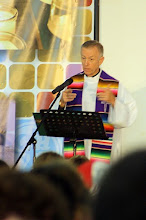The woman was upset (to use a mild descriptive) because the tabernacle in Our Savior is not directly behind the altar, but rather in a chapel area around to the side. She insisted that I consider moving it to where she regarded it as its only place.
I tried to be calm (I probably failed), but my attempts to reason with her were not productive. This was the case even though I freely admitted that the tabernacle is now where it would not be, had I been the designer of the church. But I would not have put it where she wanted it, either. When I would not agree with her, she threw the “Jesuit” question at me. I assured her I was not a Jesuit (maybe I should have said, “But I have been educated by the Jesuits”!). And so she left, very angry. [Where would I have put the tabernacle, had I been building Our Savior church? This is a difficult question! I am glad I am not in the position to have to answer it. But one model for me (for those who know it) is the “old” St Michael’s in Auburn.]
What is the great “sticking point” for people like this woman? It is, I believe, custom and a (perhaps unconscious) resentment toward all that was brought in by and is aligned with “Vatican II.,” especially in the realm of liturgy. A tabernacle in another place is not what some people are used to; they see any move as an insult to Jesus. But is this necessarily the case?
First of all, we must see what the Catholic Church says about the purpose of reservation of the Blessed Sacrament. In order, they are: 1) to bring viaticum to the dying; 2) to bring Holy Communion to the sick and for private prayer/adoration (Holy Communion and Worship of the Eucharist Outside Mass, #5).
Next, we should see what the Catholic Church says about the location of the tabernacle: “…to express the sign of the eucharist, it is more in harmony with the nature of the celebration that, at the altar where Mass is celebrated, there should if possible be no reservation of the sacrament in the tabernacle [if one exists at that altar] from the beginning of Mass.” “The place for the reservation of the eucharist should be truly preeminent…This will be achieved more easily if the chapel [of reservation] is separate from the body of the church…” (ibid, #9). “…the Most Blessed Sacrament should be reserved in a tabernacle in a part of the church that is truly noble, prominent, conspicuous, worthily decorated, and suitable for prayer….It is more appropriate as a sign that on an altar on which Mass is celebrated there not be a tabernacle in which the Most Holy Eucharist is reserved. Consequently, it is preferable that the tabernacle be located…even in some chapel suitable for the private adoration and prayer of the faithful… (General Instruction of the Roman Missal, 3rd Typical Edition, ##314-315).
It seems to me that while one can argue (reasonably) that our tabernacle’s location is not sufficiently “prominent [and] conspicuous,” it does meet the other criteria set up by the Catholic Church’s documents.
Why does this matter? In large part, it is the culmination of a trajectory of liturgical sensibility that began with Pope St Pius X and even before—to make participation in the Mass the primary purpose of a church, not to have it as simply a very large Adoration Chapel. Historically, before Pius X, there was (to put it gently) a reluctance neither to participate in the celebration in any active way, nor to receive the Holy Eucharist. Church law actually had to mandate reception of Communion at least once a year (the famous “Easter duty” from the Six Precepts of the Church). Most Catholics were far more comfortable and far more used simply to gaze, worship, adore, and go home—seemingly forgetting that the command of the Lord was “Take and eat; take and drink.” We then believed ourselves too unworthy…
Is there a place “in the center of the church” for the Eucharistic Presence of our Lord to be worshipped? Of course—during every Mass! And when you receive Holy Communion, please realize: YOU have become a “tabernacle”!
I wish we were as passionate as this woman about the way we need to take Christ into the world, rather than worrying too much about where He is “located” in our churches (do we really think we can lock Him up in the tabernacle?). Pope Francis’ challenge in his Apostolic Exhortation Evangelii Gaudium (“The Joy of the Gospel”) makes it clear that our role in the “new evangelization” is precisely to experience the presence of the Lord sacramentally as we receive the Eucharist, and then be His missionaries to those in need. Liturgical worship and private prayer do not exist for their own sake—they are they to nourish and empower us to live and be the Gospel.
I pray that 2014 will be a year of evangelical re-birth for us, to do just this. Meanwhile, I pray before the Blessed Sacrament before every Mass. I hope you’ll join me there.

I'm with you on the thought that there is no way we can lock up or control the presence of Christ. Instead, we are charged to "be what you see, receive what you are." I'm thankful we Lutherans don't have to wrestle with the tabernacle issue!
ReplyDeleteThe Orthodox don't either--at least, not in the same way...
ReplyDelete